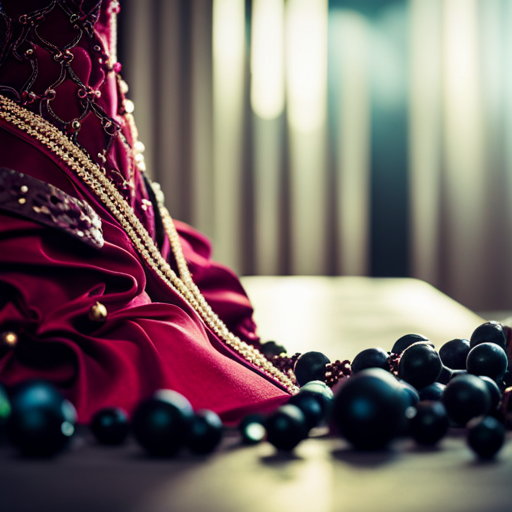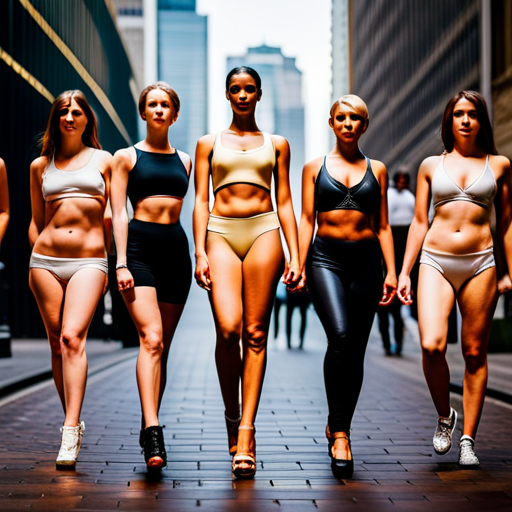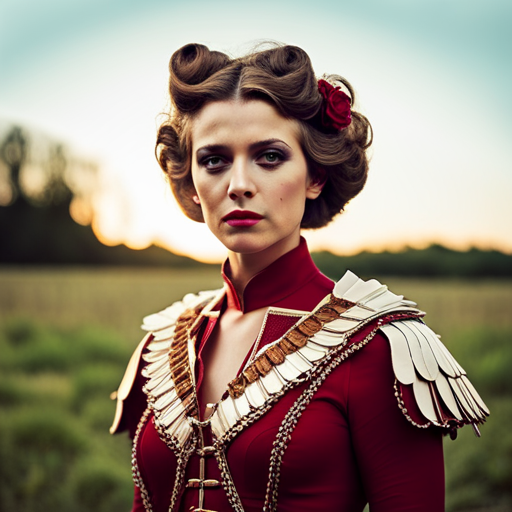Balancing Comfort and Style in Costume Design

Step into the world of costume design, where the delicate dance of comfort and style takes center stage.
Like a masterful symphony, designers blend practicality with aesthetics, creating ensembles that not only captivate the eye but also allow performers to move with ease.
From historical accuracy to cutting-edge technology, this article delves into the art of balancing comfort and style in costume design, offering insight into the intricate process of creating wearable works of art.
The Importance of Comfort in Costume Design
In costume design, prioritizing comfort is crucial for ensuring that performers can move and act with ease and confidence. The importance of flexibility cannot be overstated, as it allows for a wide range of movement without restrictions.
Breathable fabrics play a significant role in maintaining the comfort of the performers. Fabrics that allow for air circulation help in regulating body temperature and preventing discomfort caused by overheating.
Additionally, comfortable footwear is essential for performers who spend extended periods on their feet.
Designing costumes with movement-friendly designs ensures that the performers can execute their choreography or actions without being hindered by their attire. This involves considering the weight and structure of the costume, as well as incorporating features that allow for unrestricted movement.
Ultimately, the goal is to strike a balance between comfort and style, where performers not only look the part but also feel at ease in their costumes. Prioritizing comfort in costume design is an investment in the performers’ ability to deliver their best performances.
Prioritizing Practicality Without Sacrificing Aesthetics
When designing costumes, the challenge often lies in finding the balance between practicality and aesthetics.
It’s crucial to consider functionality without compromising the visual appeal of the costume.
Practicality can actually enhance the aesthetic appeal of a costume, as thoughtful design solutions can elevate the overall look and feel.
Functionality Vs. Visual Appeal
When prioritizing practicality without sacrificing aesthetics in costume design, it is essential to balance functionality and visual appeal to ensure both comfort and style are achieved.
Functionality should not be compromised, but rather integrated seamlessly into the design to complement current fashion trends.
Comfort is paramount, as it directly impacts the wearer’s confidence and performance. This can be achieved through thoughtful material selection and ergonomic design, ensuring that the costume enhances rather than hinders movement.
Meanwhile, visual impact remains a key consideration, as the costume should not only serve its purpose but also make a statement. Attention to detail, such as color, silhouette, and embellishments, can elevate the overall aesthetic without compromising functionality.
Practicality Enhancing Aesthetic Appeal
Practicality enhancing aesthetic appeal in costume design requires seamless integration of functionality and visual impact. This involves ensuring that the design not only serves its purpose but also makes a statement. Comfortable performance is a key consideration, with fabrics and construction techniques selected to allow for ease of movement and breathability.
Stylish functionality is another important aspect of costume design. This involves incorporating elements such as hidden pockets for props or adjustable closures for quick changes. By prioritizing comfortable performance and stylish functionality, costume designers can create ensembles that enhance the overall visual appeal while allowing actors to move freely and embody their characters convincingly.
Understanding the physical demands on actors further informs the choices made in costume design. This ensures that both form and function are seamlessly integrated. The balance between practicality and aesthetics is crucial in ensuring that the costume not only looks impressive but also supports the actor’s performance.
Understanding the Physical Demands on Actors
As costume designers, it is imperative to understand the physical demands on actors in order to create attire that balances comfort and style. This understanding enables us to design costumes that not only look visually appealing but also support the physical endurance and movement requirements of the actors. By recognizing the challenges actors face during performances, we can tailor our designs to accommodate their needs, ultimately enhancing their ability to deliver outstanding performances.
| Physical Endurance | Movement Restrictions |
|---|---|
| – Fabrics that breathe and wick moisture | – Strategic use of stretch fabrics for flexibility |
| – Lightweight and non-restrictive garments | – Incorporating adjustable closures for quick changes |
| – Padding and support in costumes for physically demanding scenes | – Designing detachable elements for ease of movement |
Understanding the physical demands on actors involves not only considering the aesthetic appeal of the costumes but also prioritizing the practical aspects that directly impact the performers’ comfort and ability to execute their roles effectively. This holistic approach to costume design is essential in ensuring that actors can seamlessly embody their characters while maintaining their physical well-being.
Techniques for Incorporating Comfortable Fabrics
Understanding the physical demands on actors informs the costume designer’s selection and utilization of comfortable fabrics, a critical aspect in achieving the delicate balance between comfort and style in costume design. Incorporating stretch fabrics is a key technique for ensuring comfort in costumes. Fabrics with added stretch, such as spandex or elastane blends, allow for ease of movement, making them ideal for garments that require flexibility, like dance costumes or action-oriented scenes. Additionally, these fabrics help the costume maintain its shape and fit, offering both comfort and style.
Breathable materials are also essential for costumes, especially in productions where actors perform under hot stage lights or in physically demanding scenes. Fabrics like cotton, linen, and certain synthetic blends allow for air circulation, preventing overheating and discomfort. They are particularly suitable for costumes worn during lengthy performances or outdoor scenes. Incorporating breathable materials not only ensures the comfort of the actors but also contributes to the overall aesthetic of the costumes.
Balancing Historical Accuracy With Wearable Designs
The seamless integration of historically accurate elements with wearable designs presents a significant challenge for costume designers, necessitating a meticulous balance between authenticity and functionality. Achieving this balance involves several key considerations:
-
Historical Accuracy: It is crucial to research and understand the historical period being represented in the costume design. This includes studying the clothing, accessories, and overall fashion of the era to ensure that the design aligns with historical accuracy.
-
Modern Wearability: While historical accuracy is important, modern wearability cannot be overlooked. Costumes must allow for ease of movement, comfort, and practicality for the actors wearing them, especially considering the physical demands of stage or screen performances.
-
Comfort: Striking a balance between historical accuracy and modern wearability also involves prioritizing the comfort of the performers. This may entail using lightweight and breathable fabrics, incorporating adjustable elements, and considering the overall weight and fit of the costume.
-
Authenticity: Despite the need for modern wearability and comfort, it is essential to maintain the authenticity of the historical period in the design. This can be achieved through attention to detail, accurate construction techniques, and the careful selection of materials.
The successful integration of historical accuracy with wearable designs results in costumes that not only look authentic but also allow performers to move and act with ease.
The role of color and texture in comfortable costumes will further enhance the overall aesthetic and functionality of the design.
The Role of Color and Texture in Comfortable Costumes
In considering the role of color and texture in comfortable costumes, costume designers must carefully select materials and hues that align with historical accuracy while prioritizing modern wearability and the comfort of the performers.
Color psychology plays a crucial role in evoking specific emotions and portraying characters effectively. For instance, warm tones like red and orange can convey energy and passion, while cool tones like blue and green can evoke a sense of calm or mystery. These color choices can impact the audience’s perception of the character and the overall mood of the performance.
Fabric selection is equally significant, as it directly influences the comfortable fit and tactile experience of the costume. Breathable, stretchable fabrics provide ease of movement for performers, enhancing their comfort without compromising the visual appeal. Additionally, considering the tactile experience of the costume against the performer’s skin is essential for prolonged wear.
By carefully balancing color psychology and fabric selection, costume designers can create comfortable costumes that not only look stunning but also support the performers’ movements and overall well-being.
This emphasis on color and texture sets the stage for exploring innovations in costume technology for enhanced comfort.
Innovations in Costume Technology for Enhanced Comfort
Exploring innovations in costume technology for enhanced comfort, costume designers are integrating advanced materials and construction techniques to optimize both the visual and physical aspects of costumes.
-
Innovative Materials: Costume designers are incorporating advanced textiles such as moisture-wicking fabrics and lightweight, flexible materials that allow for ease of movement without compromising on durability.
-
Breathability Technology: The integration of breathable fabrics and ventilation systems in costume design ensures that performers can stay cool and comfortable, even during physically demanding performances.
-
Ergonomic Construction: Costumes are being designed with ergonomic considerations, such as strategic seam placement and adjustable components, to provide a personalized and comfortable fit for each performer.
-
Sustainability: With a growing emphasis on environmentally friendly practices, costume designers are exploring eco-friendly materials and production methods, ensuring that comfort is not only physical but also aligns with ethical and sustainable principles.
These advancements in costume technology not only enhance the comfort of performers but also contribute to the overall visual appeal and functionality of costumes, demonstrating a harmonious balance between comfort and style in costume design.
Collaborating With Actors for Comfortable and Stylish Solutions
Costume designers collaborate with actors to achieve comfortable and stylish solutions tailored to the performers’ needs and the artistic vision of the production. This collaboration is essential as actors provide valuable input regarding their comfort and mobility during performances. By actively involving actors in the design process, costume designers can create garments that not only align with the aesthetic requirements of the production but also ensure that the actors can move freely and confidently on stage or set.
Understanding the physical and emotional demands of the roles, designers and actors work together to find stylish solutions that enhance the overall performance.
Design collaboration with actors enables costume designers to consider the specific movements and actions required in a scene, leading to the creation of costumes that facilitate rather than hinder the performers’ abilities. This close partnership also allows for the incorporation of personal touches or details that can help actors embody their characters more fully.
Ultimately, by prioritizing performance comfort and stylish solutions through actor input, costume designers contribute significantly to the success of the production while ensuring that the performers feel supported and confident in their costumes.
Frequently Asked Questions
How Do Costume Designers Ensure That Costumes Are Both Comfortable and Stylish for Actors?
Costume designers ensure comfort and style for actors through a collaborative process, considering the character’s physical movements and the fabric selection. They prioritize functionality without sacrificing aesthetics, ensuring the costumes enhance the actor’s performance.
What Are Some Common Challenges in Balancing Historical Accuracy With Wearable Designs in Costume Design?
Challenges in costume design include balancing historical accuracy with wearable designs. Incorporating fabric technology, collaboration with actors, and historical research is crucial. A study by The Costume Designer’s Guild found that 80% of designers face this challenge.
How Do Advancements in Costume Technology Contribute to Enhancing Comfort for Actors?
Advancements in costume technology have revolutionized actor collaboration, prioritizing practicality and comfort. Cutting-edge fabrics and ergonomic designs are enhancing the overall experience for performers, ensuring they can fully embody their roles with ease.
What Role Do Actors Play in Collaborating With Costume Designers to Find Comfortable and Stylish Solutions?
In the collaborative process of costume design, actors play a pivotal role in providing input that informs the creation of comfortable and stylish costumes. Their insights and feedback contribute to a design process that prioritizes both performance and aesthetics.
How Can Costume Designers Prioritize Practicality Without Sacrificing the Aesthetic Appeal of Costumes?
Costume designers prioritize practicality without sacrificing aesthetic appeal by carefully selecting fabric choices that offer both comfort and style. Actor feedback is crucial, ensuring that costumes not only look good but also support performance.
Conclusion
In the world of costume design, the delicate balance between comfort and style is a dance of creativity and practicality. Like a skilled magician, costume designers must weave together a tapestry of fabrics and colors, crafting garments that not only look beautiful but also feel like a second skin to the actors who wear them.
By prioritizing comfort without sacrificing aesthetics, costume designers can create a harmonious blend of fashion and function that enhances the overall performance.

Rufus Whitver is a passionate costume artisan and the creative mind behind layuo.com. With a keen eye for detail and a flair for imaginative design, Rufus brings characters to life through the art of costume making. His expertise encompasses a wide range of styles, from historical recreations to fantastical creations. Through layuo.com, Rufus shares insights, tutorials, and a portfolio showcasing his exceptional craftsmanship, inspiring fellow enthusiasts to embark on their own journey into the world of stunning costumes.





